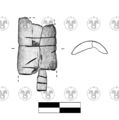SZ-23: Difference between revisions
Martin Braun (talk | contribs) No edit summary |
|||
| (9 intermediate revisions by 2 users not shown) | |||
| Line 1: | Line 1: | ||
{{inscription | {{inscription | ||
|reading=unknown! | |reading=unknown!]ilt[? | ||
|reading_original=]{{c| | |reading_original=]{{c|T|T3}}{{c|L|L2}}{{c|I|I}}[ | ||
|direction= | |direction=sinistroverse | ||
|letter_number_min=3 | |letter_number_min=3 | ||
|letter_number_max=6 | |||
|word_number=0 | |word_number=0 | ||
|line_number=1 | |line_number=1 | ||
| Line 9: | Line 10: | ||
|alphabet=Sanzeno alphabet | |alphabet=Sanzeno alphabet | ||
|language=unknown | |language=unknown | ||
|object=SZ-23 | |meaning=unknown | ||
|object=SZ-23 antler | |||
|position=outside | |position=outside | ||
|craftsmanship=engraved | |craftsmanship=engraved | ||
|condition=damaged | |condition=fragmentary, damaged | ||
|sigla_pid=204 | |sigla_pid=204 | ||
|sigla_ir=63 | |sigla_ir=63 | ||
|sigla_mancini=SA-38, SA-41 | |sigla_mancini=SA-38, SA-41 | ||
|sigla_mlr=215, 240 | |||
|source=Schumacher 2004: 137, 147 | |source=Schumacher 2004: 137, 147 | ||
|checklevel= | |checklevel=0 | ||
}} | }} | ||
== Commentary == | == Commentary == | ||
First published in {{bib|PID}}. Republished in {{bib|IR}}. | First published in {{bib|PID}}. Republished in {{bib|IR}}. Autopsied by TIR in November 2013. | ||
Images in {{bib|IR}} (photo Tav. L, fig. a and drawing) and {{bib|LIR}} (photo and drawing). | |||
The inscription erroneously bears two sigla SZ-23 and SZ-64 due to having been published twice (see [[index::SZ-23 antler]]). {{bib|PID|Whatmough}}, following Conway, read {{w||ilpṣịị}}, with the last three letters "incomplete at the top", which suggests that more was left of the upper or lower part of the three scratches, traces of which can now be seen only on the smallest fragment, before the object came apart (see [[SZ-23 antler]]). {{bib|LIR|Mancini}} and, following him, {{bib|Schumacher 2004|Schumacher}} kept the fragments separate, and therefore failed to recognise the inscription. Our reading based on the alignment of the fragments by the project's illustrator endorses the reading of the first three letters; {{p||s}} is not verifiable, although the respective scratch is slightly aslant. Despite the comparatively large lacuna before {{c||I}}, the presence of more letters in the beginning cannot be excluded. Cp. [[index::NO-4]]. | |||
The inscription is classified as being written in the Sanzeno alphabet because of the apparent presence of Sanzeno {{c||T3}} and {{c||L2}}, although there is not enough of it left to be entirely sure of its status as script. | |||
Further references: {{bib|NRIE}} 100, {{bib|Battisti 1944}}: 231. | |||
{{bibliography}} | {{bibliography}} | ||
Latest revision as of 17:16, 6 November 2021
| Inscription | |
|---|---|
| Transliteration: | ]ilt[? |
| Original script: | ] |
|
| |
| Object: | SZ-23 antler (antler) |
| Position: | outside |
| Script: | North Italic script (Sanzeno alphabet) |
| Direction of writing: | sinistroverse |
| Number of letters: | 3 – 6 |
| Number of lines: | 1 |
| Craftsmanship: | engraved |
| Current condition: | fragmentary, damaged |
| Archaeological culture: | Late Iron Age [from object] |
| Date of inscription: | 5th–1st centuries BC [from object] |
| Date derived from: | cultural context [from object] |
|
| |
| Language: | unknown |
| Meaning: | unknown |
|
| |
| Alternative sigla: | PID 204 IR 63 LIR SA-38, SA-41 MLR 215, 240 |
| Sources: | Schumacher 2004: 137, 147 |
Images
|
Object SZ-23 antler with inscription SZ-23.
|
Commentary
First published in PID. Republished in IR. Autopsied by TIR in November 2013.
Images in IR (photo Tav. L, fig. a and drawing) and LIR (photo and drawing).
The inscription erroneously bears two sigla SZ-23 and SZ-64 due to having been published twice (see SZ-23 antler). Whatmough, following Conway, read ilpṣịị, with the last three letters "incomplete at the top", which suggests that more was left of the upper or lower part of the three scratches, traces of which can now be seen only on the smallest fragment, before the object came apart (see SZ-23 antler). Mancini and, following him, Schumacher kept the fragments separate, and therefore failed to recognise the inscription. Our reading based on the alignment of the fragments by the project's illustrator endorses the reading of the first three letters; s is not verifiable, although the respective scratch is slightly aslant. Despite the comparatively large lacuna before ![]() , the presence of more letters in the beginning cannot be excluded. Cp. NO-4.
, the presence of more letters in the beginning cannot be excluded. Cp. NO-4.
The inscription is classified as being written in the Sanzeno alphabet because of the apparent presence of Sanzeno ![]() and
and ![]() , although there is not enough of it left to be entirely sure of its status as script.
, although there is not enough of it left to be entirely sure of its status as script.
Further references: NRIE 100, Battisti 1944: 231.
Bibliography
| Battisti 1944 | Carlo Battisti, "Osservazioni sulla lingua delle iscrizioni nell'alfabeto etrusco settentrionale di Bolzano", Studi Etruschi 18 (1944), 199–236. |
|---|---|
| IR | Alberto Mancini, "Iscrizioni retiche", Studi Etruschi 43 (1975), 249–306. |
| LIR | Alberto Mancini, Le Iscrizioni Retiche [= Quaderni del dipartimento di linguistica, Università degli studi di Firenze Studi 8–9], Padova: Unipress 2009–10. (2 volumes) |
